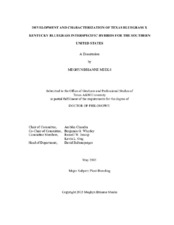| dc.description.abstract | Kentucky bluegrass (Poa pratensis L.) and tall fescue (Festuca arundinacea Schreb.) are commonly grown cool-season grasses in the United States for home lawns and various sports turf applications. However, environmental conditions such as prolonged periods of drought and heat as well as heavy shade often result in a loss of visual appeal, early dormancy, or death of the turf stand. Hybrid bluegrass (Poa spp.) cultivars derived from Texas bluegrass (P. arachnifera Torr.) x Kentucky bluegrass interspecific crosses may serve as viable alternatives for perennial turfgrass in the southern United States. Methods to aid in the breeding and selection of Texas x Kentucky bluegrasses for these environmental conditions would be useful. The goals of this research were to 1) develop new interspecific hybrid bluegrasses and optimize a seed germination technique, 2) use flow cytometry and molecular markers for the characterization of hybrid progeny, and 3) evaluate the growth response and performance of hybrid bluegrasses maintained in shade.
In 2012 and 2013, controlled pollinations were made between different Poa species. Seed from these crosses were germinated through two different techniques that resulted in 61 new interspecific hybrids. A higher percentage of individuals (89%) were recovered through germination on nutrient agar medium than soil. In addition to these hybrids, 52 Texas x Kentucky hybrids created in 2001 were tested for three years in multiple locations across the southern states and the transition zone. Experimental hybrid TAES 5653, registered as DALBG 1201, was the superior genotype.
Flow cytometry was used to estimate the DNA content of 19 Texas bluegrass genotypes, and four Texas x Kentucky bluegrass hybrids from two different pedigrees. Variability in DNA content suggested variability in the ploidy levels of Texas bluegrass. Texas x Kentucky bluegrass interspecific hybrids had an intermediate DNA content demonstrating flow cytometry can identify true hybrids between parents with vastly different DNA content. A thioredoxin-like (trx) nuclear gene was also useful in identifying true Texas x Kentucky bluegrass hybrids. A distinctive 851 bp trx allele with a 163 bp insertion site was also identified. The insertion is evidently a transposable element that may help to elucidate ancestors of Texas bluegrass.
Another study was conducted to develop a method of comparing Texas x Kentucky bluegrass hybrids to commercial cultivars for shade tolerance. It was determined that evaluations should be conducted in the spring to early summer months using moderate shade (50%) levels, and high turfgrass quality and slower leaf elongation rates as selective traits. Trinexapac-ethyl was not necessary to reduce the leaf elongation rate or increase quality of dwarf hybrids under shade.
In summary, several methods have been tested to generate and evaluate new Texas x Kentucky bluegrass hybrids. Seed germination conducted under controlled conditions using agar medium, and flow cytometry and the trx nuclear gene can be employed in bluegrass breeding programs to identify true interspecific hybrids. Finally, improved dwarf-type hybrid bluegrasses, such as DALBG 1201 and TAES 5654, seem to have enhanced shade tolerance and potential for use as perennial turfgrass alternatives in the southern and transition zone regions of the United States. | en |


